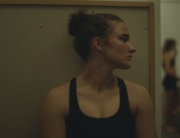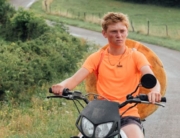An entire genre of films exists that focuses on life on the desolate Central Asian steppes, in which families live traditional lives alongside the modern world. These hybrids of ethnology and narrative storytelling were a short-lived trend about 10 years ago. The Story of the Weeping Camel (2003) centered on a multigenerational family of herders trying to convince a mother camel to bond with her newborn calf, while the winsome Tulpan (2008) told a straightforward tale of a young man trying to win over the woman he wants to marry (and has even more camels). Though it was fictionalized, the vérité camerawork and nonprofessional cast gave Tulpan a documentary feel. This was likewise true of Mongolian Ping Pong (2005), in which a found object, a ping-pong ball, became a source of wonderment for three kids on the plains.
Set in Mongolia, The Eagle Huntress similarly immerses viewers in the nomadic lifestyles of Kazakh herder Nurgaiv and his daughter Aisholpan. A straight-A student with rosy cheeks and braided tails, Aisholpan hopes to become a doctor one day. She spends the week attending school in town, returning home on the weekends to the family’s portable ger. There, her father guides her to achieve another goal: to become a master hunter. Bucking tradition, she would become the only female in her community to accomplish this feat. To do so, the 13-year-old must raise and train an eaglet to forge a lasting bond—the winged predators are used to hunt foxes for winter ware, swooping down on them before gliding back to their owners.
In the film’s mesmerizing, white-knuckle high point, she climbs down a steep cliff to an eagle’s nest. As the mother eagle circles above, Aisholpan, tethered to a rope held by her father at the top of the cliff, places a burlap bag over a squawking, thrashing, and bewildered bird to spirit it away. Here a GoPro camera was attached to Aisholpan’s sweater, and as a result the viewer feels very much there (so much so that the film should come with warnings of vertigo).
Aisholpan has six months to train her feathered protégé so she can participate in the Golden Eagle Festival. The sole female to compete against 70 males, she will be judged both on her hunter’s outfit as well as the eagle’s flying skills—specifically, its speed soaring from a mountaintop to Aisholpan’s arm, on which it will perch. However, Nurgaiv, as well as the grumbling male onlookers, believe the true test of her skill will occur when she travels into the wintry mountains to hunt.
The film offers a countdown to the fateful day she and her eagle will face the community’s scrutiny, but The Eagle Huntress is only nominally a kid-in-a-competition documentary (another trend from 10 years ago). The editing tries to build conflict through many male talking heads declaring that females are weaker and more fragile than men, but the movie’s overall vibe is gentle and good-natured. Any divisiveness exists firmly outside of Aisholpan’s home life, in which she has the support of both of her parents. The family-friendly film works best in simply reporting how Aisholpan tames her golden eaglet, though it often takes a conventional route in doing so. That includes blasting Sia’s on-the-nose “Angel by the Wings” anthem, with its refrain “You can do anything,” during the closing credits.
Meanwhile, say what you will about drone technology, but it aids and abets the already majestic and extraordinary footage, captured by first-time feature documentary filmmaker Otto Bell. The landscape lends the film an epic grandeur. Bell and his team filmed on location in the rocky, snow-peaked Altai Mountains of northwestern Mongolia for nearly a year, and while watching the film, you can sense how isolating and arduous the shoot was; temperatures plunged 40 degrees below zero.
The Eagle Huntress plays like an extended episode of Nature or BBC Earth, but with more a thorough examination of its subject. It’s no shoot-and-dash endeavor, and like those two visually-dazzling programs, the footage and camera work are amazing. Bell shot from all angles, including an “eagle cam” attached to a dog’s harness—it is as close to a bird’s-eye view as you can get.

















Leave A Comment